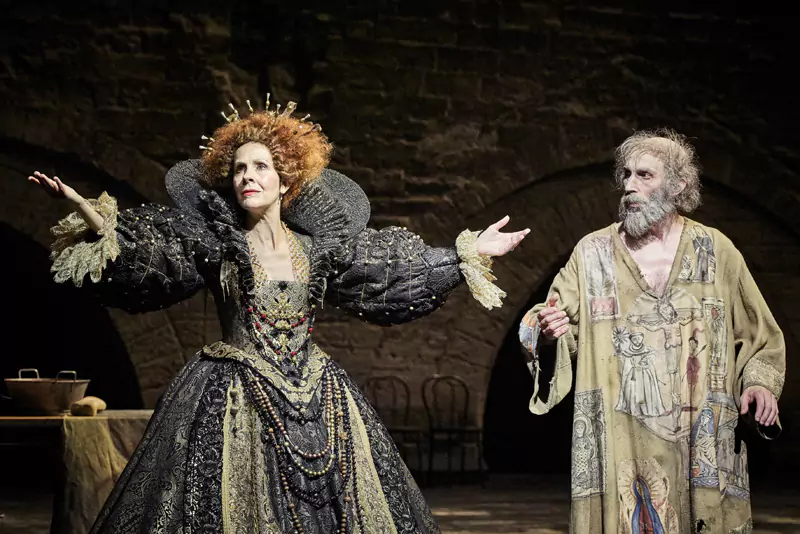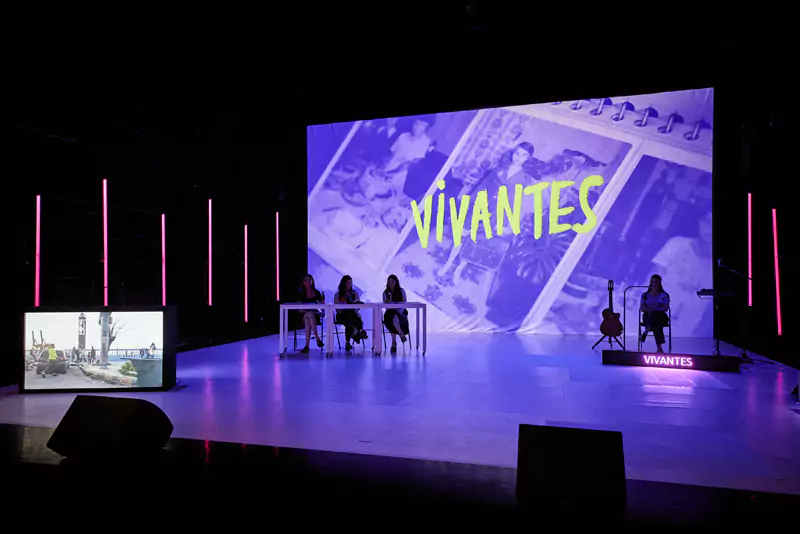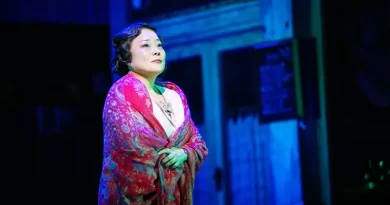The 79th Avignon Festival
Robert Schneider
2 August 2025
Few westerners have ever heard a skilled actor speaking Arabic; the language strikes the ear as rich, varied and powerful. Current news broadcasts mean that Arabic has become associated, even subliminally, with conflict and sectarianism. The Avignon Festival wants to redress the balance as much as possible. After English in 2023 and Spanish in 2024, Arabic is this year’s guest language.
It’s an interesting choice because more and more Arabic speakers encounter the language principally as one encounters it in theatre—orally. Although it’s the world’s fifth most-spoken language, Arabic publishing is on the skids; it probably accounts for substantially less than 1% of world output, perhaps 20,000 works a year—fewer than Greek and about half as many as Turkish. Newspaper readership is also in decline. Of the world’s major languages, Arabic—despite the federating influence of the Koran—seems most in danger of slipping into orality. Censorship, political repression and regionalisms all play a role.
Arabic fares no better on stage: Sunni Muslims reject theatrical representation outright; Shite Muslims have their own theatrical tradition of Ta’zieh, but it’s usually performed in Farsi, not Arabic. (Ta’zieh was a major feature of the festival in 1991.) In consequence, few traditional dramatists write in Arabic, almost all of them are expatriates. Most of them have been invited to the festival.
The festival has fleshed out the programme with a good many dance performances from the Arab world. Some of them, like Mohamed Toukabri’s Everybody Knows What Tomorrow Brings and We All Know What Happened Yesterday feature voiceovers in Arabic. Nearly all the Arabic I heard at the festival came in the form of pre-show announcements telling me to turn off my cell phone, refrain from taking pictures and enjoy the show.
Le Soulier de Satin by Paul Claudel, directed by Éric Ruf
How to guide 2,000 audience members through a sprawling philosophic drama in the course of a single summer night? The Satin Slipper, to use its English title, is notorious for jumping from continent to continent over the 50 years of its action. In a career, a director will probably only have one chance at it. How do you proceed?
First, cut some of the author’s longer disquisitions on Art, Grammar Reform and Catholic mysticism. This will reduce your running time to seven hours from the original eleven.
Next, direct the play as if the dramatic situation actually matters. Don’t assume it’s just an armature for Claudel’s philosophic musings.
Use wonderful actors from the Comédie Française: Marina Hands as Doña Prouhèze; Baptiste Chabauty as Don Rodrigue; Christophe Montenez as Don Camille and Didier Sandre who played Rodrigue for Vitez in 1987 and now plays Don Pélage. Let them fill the cavernous space with their individual and collective presence.
Be playful and positive. Help the audience through. In the Prague scene, after Doña Musique’s extended standing prayer, bring the house lights up and teach the audience to sing the melody that music director Vincent Leterme composed for the occasion. In fact, allow as much interaction as possible between the characters and Leterme’s on-stage musicians—they are all in this together.
Have actors enter from the house and play in the aisles. Allow occasional ad-libbing. One example: on opening night, when Doña Prouhèze had attached her slipper to a helium balloon which wafted it clear out of the Papal Palace courtyard—her offering to the Virgin so that she might only limp towards a sexual dalliance with Rodrigue—the next actor to enter complained, “You’re all watching the balloon and not me!”
Do away with scenery—you are already playing in a palace, after all—but make the most of Christian Lacroix’s gorgeous costumes, bravura lighting by Bertrand Couderc and thunderous sound by Samuel Robineau.
Don’t let anything fade out or fade in. Go from one scene to another with the violence of an eight-year-old turning the pages of a story book.
Finally, provide 30-minute intermissions every two-and-a-half-hours. Your audience will get through it well and thank you roundly afterwards.
Director Ruf, who followed all of my suggestions (indeed, he invented them) is leaving the Comédie Française after 11 years as general administrator. He has this to say about the Soulier de satin: “The play is reputed to be impure, a mixture of theatre and some kind of religious exercise. That’s not it at all. It’s the work of a man who’s giving battle, battling with God, seeking confrontation, trying to get things in order … It’s a play for actors who will throw themselves into it like a double black diamond ski trail that nobody’s done in a long while.”

Le Soulier de Satin.
©Christophe Raynaud de Lage / Festival d’Avignon.
Mami by Mario Banushi
Mami, by 26-year-old Greco-Albanian choreographer Mario Banushi, is a wordless theatrical meditation on courtship, mating, motherhood, grief, healing and death, but not in that order. Six performers, often nude, evoke the highlights of the human resumé in images that are heartbreakingly beautiful. Each tableau morphs into the next at a pace that honours the solemnity of the moment without denying that the peak experiences of life are fleeting—like life itself.
If you can imagine Pina Bausch without the irony or a Fellini movie with nothing grotesque; it’s like that.
Jeph Vanger supplies a poignant but understated soundscape.
The scenography and costumes by Sotiris Melanos appear basic, but they englobe a sequence of magic tricks performed in slow motion. As an actor exits, her dress catches in a door. We think it’s an accident, but when the door opens later, another actor is attached to the dress.
A small, square house slowly tilts backwards, hinged where it meets the stage on the upstage side. The actor we saw go into it earlier has vanished. Where did he go?
An actor pedals a bicycle around a dark stage. We see only see only the headlight on the bicycle until it stops, pointing downstage. When a dwarf actor cuts the beam of the headlight wearing a white costume; the cyclist is finally illuminated by light reflected off the costume.
Banushi’s ideas are primal to the point of becoming Biblical: a woman gives birth to two adult males. They wrestle for dominance. The victorious brother might easily sound a ram’s horn, but instead, it’s the defeated brother who is handed a clarinet and plays it plaintively. Earlier, he had courted the woman/lover/mother using the same clarinet. Banushi has little interest in conventional chronology or consistent characterizations. It’s understood that each person in their time plays many roles.
Like Bausch, Banushi works on the cusp of theatre and dance; he enacts rituals without words and tells intricate stories without language.

Mami.
©Christophe Raynaud de Lage / Festival d’Avignon.
Les Perses by Aeschylus
Peter Brook showed us how hard it was to be simple. Gwenaël Morin has learned that lesson at Avignon over time. Every year he produces a classical text with local actors. This year, in a dusty patch of ground that was once a papal garden, he has produced Aeschylus’ The Persians with four actors and a scarcely larger number of lighting instruments. The actors wore their own clothes. The props were a litre cube of goat’s milk, a bottle of local wine, a few strands of plastic ivy and an empty plastic bucket. Thanks to the magic of theatre, these became offerings at a Persian temple, a garland to bedeck the temporarily resurrected cadaver of king Darius, and an empty quiver—the sole material remnant of Xeres’ vast army sent to invade Greece. A single drum supplied the music, just enough to give the choral parts an intentionally monotonous underscoring, a trick to highlight the principal roles.
This rudimentary staging reveals the solidity of Aeschylus’ dramaturgy and puts the task of storytelling squarely on the backs of the actors—where it belongs. The production picks up the tragedy where Aeschylus left it: no elaborate images, few anachronisms and no hastily-drawn parallels with modern Persia (aka Iran) caught in the bomb sights of Israeli and American pilots.

Les Perses.
©Christophe Raynaud de Lage / Festival d’Avignon.
Radio Live by Aurélie Charon
Forty years ago, it was quite the fashion to embellish theatrical presentations with video. Robert Wilson did it. Elizabeth LeCompte did it. Today the tendency is inverted, three-dimensional actors serve as knick-knacks to frame flat ones.
At Avignon this year, the crafts of spoken drama were used to illustrate podcasts, spice up choreography and provide on-stage audiences for movies. The worst example is probably Radio Live, a series of three shows totalling nine-and one-half hours purporting to be radio documentaries. Dominated by a projection screen forming the entire back wall of the Théatre Benoît XII, however, the setup reads as “television,” not “radio.” Our status as audience members is ambiguous: are we watching the taping of a TV show? Or the finished show as it would be broadcast—with the people on the screen miraculously present in the flesh as well?
Radio Live interviews women who survived political disruptions in their home countries and subsequently moved to Europe. In the first series, Vivantes, a Bosnian art historian and activist (Ines Tanović) recounts her memories of growing up in Sarajevo, a Syrian actress and filmmaker (Hala Rajab) recalls the civil war in her country and a Ukrainian actress and teacher (Oksana Leuta) tells of her experience working as a “fixer” for French journalists covering the Russian invasion. Subsequent series take the audience to Gaza and other trouble spots. I left after the first one.
We feel admiration rather than pity. The witnesses are attractive, accomplished women with solid educations and professional credentials. They are witty without being flippant. The stories they tell are terrible without being squalid just as the television show they seem to be taping is informative without being especially compelling.
And what exactly is the subject? Is it abuse or the recapitulation of abuse by mass media? Radio Live is documentary theatre that mostly documents its own methods.
Tanović recounts her middle-class girlhood in Sarajevo. She speaks in English; everything she says is translated sequentially by the show’s creator, a producer at France Culture named Aurélie Charon whose acid-yellow dress and black army boots struck me as incongruous. Charon’s translations are word-perfect, a clear sign that she knows what’s coming. If the show isn’t entirely scripted, it’s clear that nothing unexpected will occur.
Indeed, the un-liveness of Radio Live is glaring. The interviews are lavishly illustrated by prepared-in-advance video clips that often eclipse the live participants entirely. At one point the three women are seated downstage, their backs to the audience, looking upstage at a video of themselves in which they appear to be looking downstage at another video, a Skype call to Tanović’s mother back in Sarajevo. Tanović’s mother (the thing they’re ostensibly looking at themselves looking at) becomes visible on another screen toted in for the occasion.
Where is the action here? And wither the act of representation? The participants are called upon only to represent themselves, witnesses-turned-media-people. The stories they tell are of themselves telling their stories.
This said, the means employed are impressive. A graphic designer (Gala Vanson) seated at a laptop to one side contributes illustrations on the fly. Clips and incrusted videos illustrate everything mentioned. A musician, Emma Prat, sings and plays the songs the guests remember from their childhoods. Her gorgeous, bell-like voice and strong instrumental skills were the highlight of the production for me.
Thirty years ago, the Avignon Festival reacted to the massacres at Srebrenica with a shriek of outrage. Olivier Py painted a cross on his set of La Servant as a protest; hundreds of festival-goers played dead in front of the Papal Palace to represent the corpses. By comparison, Live Radio is tepid, a radio playing in the next room.
At the end, the audience members rise to applaud the brave victims while congratulating themselves for having all the right opinions. Yes, we reprove Bashar al-Assad, Radovan Karadžić and Vladimir Putin, but we have no idea how such men come into being. Productions like this—which American playwright Mac Wellman derided as “the theatre of good intentions”—never allow us to confront the evil within ourselves. The evil is always elsewhere. It’s bad. Those men are bad. We hate their badness, but it has nothing to do with us.

Vivantes (Radio Live)
©Christophe Raynaud de Lage / Festival d’Avignon.
Vive le sujet! Tentatives
This a portal to new work co-produced by the SACD, the French guild of playwrights and composers. Every year it commissions several experimental works that mix the disciplines of dance, theatre and design. This year it presented six shows; I saw two of them. The first, Born Again, introduced me to three exhausted primary school teachers (Yasmine Hadj Ali, Antoine Kobi, Ike Zacsongo-Joseph) looking after a kindergarten student whose mother always comes late to pick him up.
They seek to amuse the child (whom we never see) with a game of hide and seek. The three of them get so caught up in the game that it takes a while for them to realize that the child isn’t just hiding—he’s gone missing. In the panic that ensues, the three adults flash back corporally and vocally to moments of analogous anxiety in their own childhoods. The police arrive. When questioned, the teachers recount every time and indicate every place where they have spoken dismissively to a child. Each becomes a crime scene: a numbered marker is set on the ground and pictures are taken. Each in their own way, the author-performers allow feelings of abandonment and neglect to surface from long ago. There’s a lost child inside us all.
In the second show, Quel aurore, two young women (Soa Ratsifandrihana and Bonnie Banane) rehearse a dance routine on treadmills so they can put it on TikTok. Afterwards, as they scroll through their phones, they stumble on a gruesome first-person account (in English) of an air raid in Gaza. This depresses them and they appear to wilt. They roll on the ground for a while. Gradually their spirits revive and they go back to dancing.
That’s it. There’s only one idea here. The pace is glacial. In consequence, the number of ideas-per-minute is zero followed by a small decimal.

Vive le Sujet.
©Christophe Raynaud de Lage / Festival d’Avignon.
Le Sommet by Christoph Marthaler
This promised to be livelier, a comedy worked up as a création collective by three theatres bordering the Alps: Théâtre Vidy-Lausanne, Piccolo Teatro di Milano and MC93 in France. The show features two performers from each. The actors speak all the languages they know and intermittently get together to sing songs. The unifying idea, if you could call it that, is that these six people have climbed a mountain and are now occupying a chalet at the summit. Their meeting is also a summit in the other sense that crucial conversations take place between and among highly-placed personalities.
Parts of the summit seem to have been well prepared: the characters consult thick briefing books as they offer a quick round robin of nonsense syllables culled from different languages. Other parts seem improvised; at one point all the characters are in a sauna. A fax machine spits out a yards-long document which makes them all laugh silly laughs.
Still other parts are reactions to circumstance: the roads have been washed out; loudspeakers inform the participants that they might be up on the mountain for years. A Swiss-German man makes a dash for the outhouse which promptly collapses. (Ha, Ha)
There are other bits which didn’t make sense to me at all. One of the Italian women is a religious fanatic who reveals her stigmata. A French woman makes a long speech in which she complains that no one understands her when she talks. A helicopter drops 40 or more red, vinyl balloons that the cast quickly inflate. They turn out to be fire extinguishers.
Unfortunately, there’s little chance of this catching fire dramatically. The action is arbitrary without making any point about arbitrariness. It’s not Ionesco. The author-interpreters seem convinced that non-sequiturs are always droll. (They aren’t.) The loudspeaker announcements are repeated in several languages, but translated in the supertitles on each occasion; by the time you hear the announcement in your own language, you’ve read it two or three times—which kills the joke. Director Marthaler also believes that if a bit isn’t funny the first time, it should be repeated.
Le Sommet must have seemed wacky and off-the-wall in rehearsals. I imagine the multi-national cast all presenting different bits, each tugging the show in a different direction. I felt sorry for them at the curtain call. It was clear from the audience reaction that funny is a mountain which Le Sommet had failed to climb.

Le Sommet.
©Christophe Raynaud de Lage / Festival d’Avignon.









